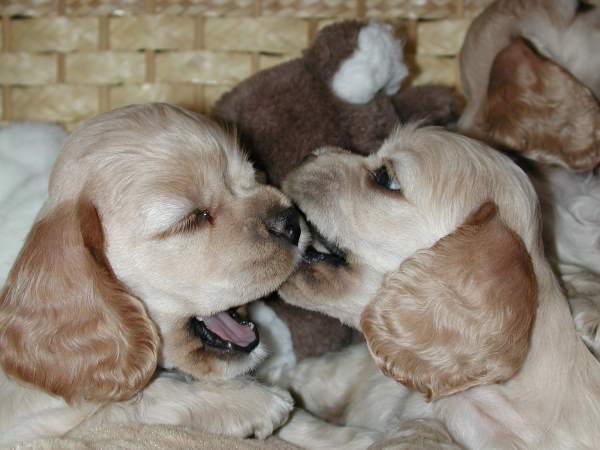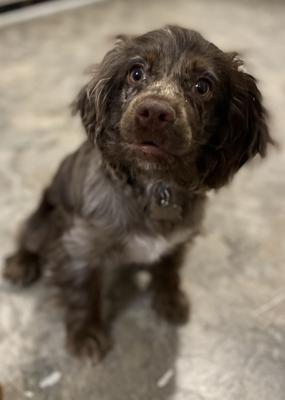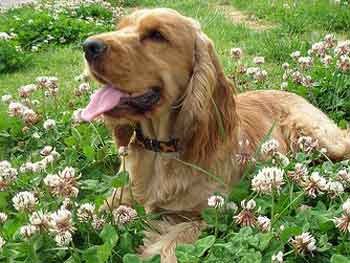- Home
- Puppy training
- Crate training puppies
Crate Training Puppies
7 simple steps to crate training puppies to help you give your Cocker Spaniel safety and comfort, a safe place to retreat when the kids get too boisterous, or things get too much for him.
If you're going to crate your puppy successfully, he'll need to feel safe and comfortable in and around his crate. If his experiences are positive and his training isn't rushed, he'll adopt (and love) his new home much more quickly.
Learn how to crate your puppy the right way!
7 Simple Steps To Crate Training Puppies
I recommend you read the essential rules of crating first, as it will help you to get the best results for you and your puppy.
When you've read that, come back here and follow the steps below.
Step 1: Crate Training Puppies: Introductions
Your first step is to introduce your puppy to his cage. You need to make sure that his experiences with his crate are positive if he is to be comfortable and enjoy using his crate.
Show your little boy that good things will happen to him when he's in or around his crate. This will help encourage him to accept his new den quickly and calmly.
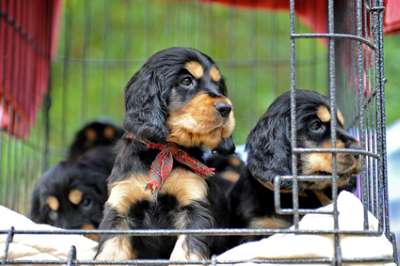 Crate training a puppy is highly recommended!
Crate training a puppy is highly recommended!Entice your puppy into his crate quietly, calmly, and without any stress.
You've already placed a soft blanket inside. Preferably the same blanket with the scent of the puppy's mother and siblings, so it will already smell like home. That's a bit step forward.
Crate Training Puppies: Getting Him Used to His Crate
Begin by sitting outside of the crate with your puppy by your side, and do the following:
- Slowly open the door and then feed your pup a small training treat. Stroke your puppy and talk to your puppy in a loving tone.
- Let your puppy explore the crate if he wants to, and if he goes inside, reward him with a treat.
- If he isn't interested in going inside, place a couple of treats on the floor outside the door, and throw a few treats inside the crate.
- Let him eat the treats on the floor. He may put his head inside the crate to get the remaining treat, in which case, praise him and drop another morsel inside, but this time throw it further back to entice him to step inside.
- If your puppy goes into the cage, praise him and give him another treat. Let him explore a little, and then call him to you. If he comes out when called, reward him with a treat, but never reward him for coming out unless you've asked him to do so.
- Repeat the above exercise several times until your pup seems comfortable with going in and out of his crate.
When crate training puppies, you need a gentle hand if they're to get used to their cage quickly and without trauma; never force your puppy to do anything he doesn't want to.
Remember, this should be fun!
TIP: When crate training puppies, it's best to train when it's quiet and when there's little going on around, otherwise, your puppy will become easily distracted, and the chances are you won't make much progress.
Step 2: Crate Training Puppies: Closing The Door
Your next step will be accomplished when you can close the door to the crate with your puppy inside and not have him react.
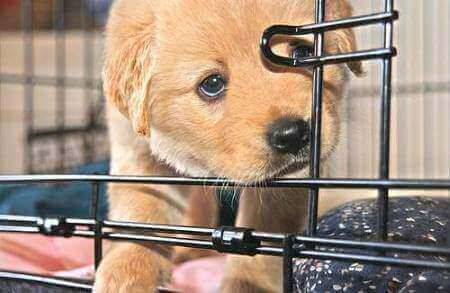 My puppy crate is my home sweet home!
My puppy crate is my home sweet home!So, here goes:
- Place your puppy's favourite toy inside the crate and throw a couple of treats inside, towards the back of the cage. When your puppy goes inside, quietly close the door for a few seconds.
- Open the door just as he's finishing his last treat.
- Try the above exercise again, but this time leave the door closed. When your puppy has finished the treats, it may settle down in the crate and play with a toy. However, your puppy may whine and want to be let out.
- If he whines, try feeding him a couple of additional treats through the bars to quieten him before opening the door. (If you open the door as soon as he cries to be let out, he may learn that crying gets him what he wants!).
- Repeat the above exercise until you can leave your pup inside for several minutes, gradually building up the time he spends inside.
Once you reach this point, you can drop his reward for coming out of the crate when called.
When crate training puppies, it's always better to reward your pet more for going into his crate and less for coming out; help him to learn that it's more fun to be inside the cage than out of it!
When crate training puppies using treats as a reward, remember to offset the treats against your puppy's food allowance; otherwise, you may end up with an overweight Cocker Spaniel!
Overweight puppies grow up overweight dogs, which is not healthy!
Step 3: Crate Training Puppies: Feed Him In His Crate
Feeding your puppy in his crate is a good idea because it's another way of reinforcing that good things happen when he's in his crate.
Yet another positive experience for him!
- To begin with, place his food bowl just outside the door and let him eat.
- Move his bowl inside the cage for his next meal, and gradually move it deeper inside the crate each meal time until it's in the back corner.
- When he's inside eating, close the door gently behind him.
- He may be engrossed in his meal, but he may want to be let out immediately, in which case, open the door and let him come out, but leave his food bowl inside and close the door again.
- Don't praise your Cocker at this stage; just remain quiet.
- If he's hungry and tries to get back into his crate for his food, open the door and let him in. (Your aim is to have him ask you to open the door).
- If your puppy doesn't want to go back inside, leave the door open and leave him to it. If he's hungry, he'll eventually wander inside and eat...and when he does, quietly and gently close the door.
- Open the door just as he's finishing his food.
Repeat the above steps for each meal, leaving the door closed for longer each time.
Remove the food bowl, offer your Cocker some water, and then take him outside to his toilet area. Praise him if he does the business, and then reward him by playing with him for a little while.
During this stage of crate training puppies, please be aware that not all pups react in the same way or develop at the same pace. This training step may need to be attempted several times before your Cocker becomes comfortable with his crate door being closed.
Take your time and be patient!
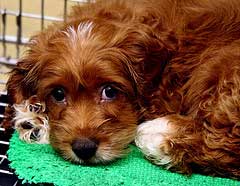 My crate, my space!
My crate, my space!Step 4: Teach Your Puppy To Enter His Crate on Command
Once your Cocker Spaniel puppy is comfortable entering and leaving his crate, it's time to stop using treats to bribe and reward your puppy. Use enthusiastic praise instead, otherwise you will end up with an overweight puppy!
Now you're going to teach your puppy to go into his crate on your command!
Choose Your Command and Get Your Puppy Used to Hearing It!
First, choose your command word or phrase. I use "into bed" for Max, but you can use whatever words you feel comfortable with.
Introduce your puppy to this command and get him used to hearing it. The best way to do this is to say your chosen words just as he's going into his crate.
Timing is crucial if your puppy is to begin linking his going into his crate with your command words. Practised regularly, he'll soon learn that your command words (in our case, "into bed") mean that he is being asked to go into his crate.
Once it's evident that he understands these new words, you can use them as a direct command and watch your little puppy trot into his crate when you ask him!
 Crate training puppies is kind, not cruel!
Crate training puppies is kind, not cruel!Using Your Command Words To Get Him Into His Crate
Here's how:
- Ask your puppy to sit just outside of his crate.
- Say the command enthusiastically but not over-excitedly. You could give your puppy a helping hand by pointing to the crate.
- If he goes inside, praise him and give him a small treat to help him understand that he got it right!
- If your puppy refuses to go into his crate, don't ask him a second time, and don't throw in any treats to entice him inside. Stick to your guns and wait it out!
- If your puppy still doesn't move, end the training session.
Don't be angry and don't say anything to him; you can always try again in a few minutes.
Practice the above lessons whenever you get the opportunity, and you'll soon have your puppy going in and out of his crate on command!
If you feel you've moved on too soon, simply go back a step and come back to this again when he understands more.
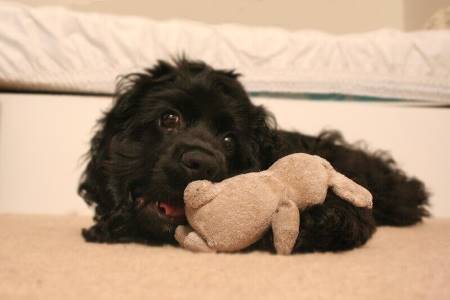 Hi, this is my favourite toy!
Hi, this is my favourite toy!Step 5: Crate Training Puppies & Lock Down!
I strongly recommend you help your puppy get used to being locked inside his cage for short periods while you're home before leaving him on his own.
If he's locked in his crate but can still see you, he's more likely to feel settled. It will also help stop him from associating being crated with being left alone.
Your puppy is in his crate and playing with his favourite toy - great!
Now you can begin this part of his training:
- Move out of his sight for about 30 seconds and then return.
- If he's standing up, looking for you, you can reward him with a stroke through the cage bars, or you can feed him a training treat, but don't say anything and don't make a fuss.
- If your puppy is still lying down, playing with his toy, success!
- You can now practice moving out of sight as often as time permits. You aim to gradually increase the time you stay away and for your puppy to realize that you always return.
Take your time with this part of his training; don't be tempted to rush.
To get it right, crate training puppies should be done in small, gradual stages.
Give your little boy plenty of time to get used to his crate, and you'll soon see that he'll settle down quietly when you're not around.
Step 6: Crate Training Puppies: Leaving Him
Your aim now is for him to get used to being locked in his crate when you're not around, but this must be done gradually.
The hardest part of crate training puppies is when you have to leave them on their own.
However, if your puppy is comfortable in his crate and hasn't had any unpleasant or distressing experiences, there should be no reason why you can't leave your puppy locked in his cage for a little while.
Before you lock your puppy in his crate, there are a few things you can do to help make it easy for him:
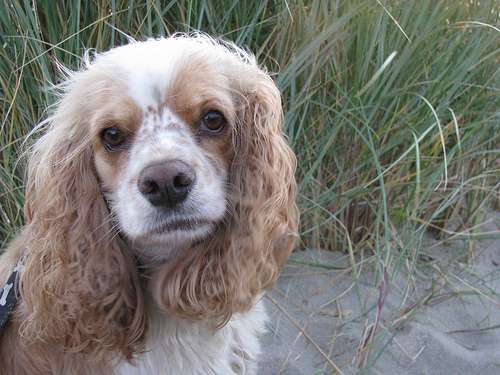 I have a crate at home, and I love it!
I have a crate at home, and I love it!- Take him outside into the garden and see if he wants to pee.
- Let him have a little playtime and exercise beforehand to help tire him out - he may even fall asleep in his crate while you're away!
- Remember to remove your Cocker Spaniel's collar before you lock him in his crate - safety first!
- Don't make a fuss when you leave; no long goodbyes; simply go quietly.
- When you first begin crate training, I recommend you leave your puppy for an hour at maximum until he gets used to being alone.
Leaving Your Puppy For Longer
If you need to go out to work, there are several ways to ensure your puppy is safe and happy.
For example, you can come home at lunchtime. If that's not feasible, consider paying a dog sitter or hiring a dog walker to look after him.
You may have a friendly neighbour you could ask to pop in and feed your puppy and take him out in the garden daily.
If left alone for too long, some puppies can develop what's known as separation anxiety.
They can become quite stressed and anxious, which isn't a good state for your pet to be in. It can also lead to destructive behaviours, and a puppy with severe separation anxiety can trash a room in the blink of an eye!
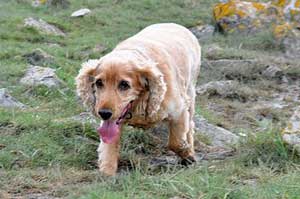 Can't wait for a lie down in my crate, Mum
Can't wait for a lie down in my crate, MumStep 7: Crate Training Puppies: His First Night!
This section assumes your puppy has already been crate trained by the breeder and applies to your puppy's first night in his new home inside his crate.
Here are some tips on what you can do to help him feel relaxed:
- Exercise your Cocker in the evening, play games with him and let him play with his toys to help wear him out!
- It's best if you don't give him anything to eat or drink after 7:00 pm.
- Before you put your pup into his crate for the night, take him outside to his toilet area and encourage him to pee. When you're sure his bladder is empty, bring him inside, put him in his crate, and leave him.
What If My Puppy Cries During the Night?
You can almost guarantee that your puppy will cry during his first night as his new home will be unfamiliar to him, and he'll probably miss his mother and litter mates.
You have two choices for his first night in his cage:
- put his crate in another room where you can't hear him crying or bring it into your bedroom, where you can comfort him if he cries during the night.
Either is acceptable, but I'd recommend the latter for his first night. If you place the cage by your bed, you should be able to reach out to reassure him if he wakes.
Crate training puppies (especially if your pup has just arrived in his new home) can be very stressful for you both.
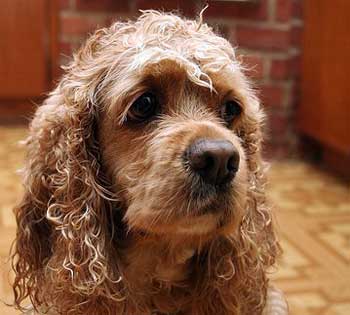 I look sad, but I'm not!
I look sad, but I'm not!If your puppy does cry at night, don't allow him out of his crate unless you're confident that he wants to pee, in which case, take him outside to his toilet area and wait with him.
If he pees, quietly praise him and bring him straight back to his crate; no playing or fussing. Your baby must learn that night-time is not for playing.
You may need to do this every 2 or 3 hours during the night for his first few weeks, but this will quickly improve when he can hold his bladder and bowels for longer.
At 3 months, a puppy can usually go all night without a bowel movement as long as he's been allowed to relieve himself before being put to bed.
Benefits of Crate Training a Puppy
Crate training your puppy is one of the kindest things you can do for a young pup, and despite what some people think, crating it isn't cruel.
Your puppy's crate becomes his safe haven, a place to retreat when family life gets a little too hectic for him. His crate will become his den, and he will love it.
His crate will help him adjust to his new family environment without fuss or stress.
Crate training puppies can also help with toilet training because dogs don't like to 'pee on their own doorstep' and will try to hold it if locked in their crate.
Don't get me wrong, they'll pee in your kitchen as soon as you let them out, but that can be managed.
Crate training puppies is one of the best things you can do for them, but if you need further convincing, you can learn more about the benefits of crate training your puppy here.
You're simply providing him with the exact type of home he'd be looking for in the wild, a safe, den-like hide to protect him from predators and bad weather.
Your breeder may have already begun introducing your puppy to a crate, and you must continue the process.
Crate training puppies can take a couple of days or several weeks; it all depends on HOW it’s done. If your puppy is calm and relaxed, it may only take a few days, but if he’s stressed or anxious, he may never accept his crate.
Crate Training Puppies: Tips And Techniques
As I said earlier, crate training your puppy isn't cruel.
You're simply providing him with the exact type of home he'd be looking for in the wild, a safe, den-like hide to protect him from predators and bad weather.
Your breeder may have already begun introducing your puppy to a crate, and you must continue the process.
Crate training puppies can take a couple of days or several weeks; it all depends on HOW it's done. If your puppy is calm and relaxed, it may only take a few days, but if he's stressed or anxious, he may never accept his crate.
Puppy Crate Training: Don't Force It!
Crate training puppies shouldn't be traumatizing; it shouldn't be a stressful or frightening experience; otherwise, your puppy may never accept his crate.
Please don't ever try to force him into his cage, and try not to show disapproval or sound angry if he gets it wrong. Keep the training light and make it fun!
Try throwing his favourite soft toy, a chew bone, or a few small treats inside his cage from time to time so that if he wanders in without being prompted, he'll get a pleasant surprise.
If all his experiences inside his crate are positive, he'll soon love his new little den.
Crate Training Puppies & Whining
When crate training your puppy, there will probably be times when he cries or whines to be let out.
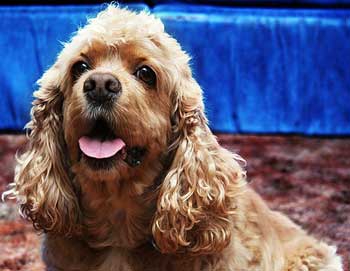 Hello Mum!
Hello Mum!You mustn't pay any attention to your puppy if he cries or whines while he's in his crate. If you do, your Cocker Spaniel will soon learn that crying is the way to get your attention, and he'll do it all the more.
Wait until he's stopped crying for at least 10 seconds before letting him out.
If he doesn't stop crying, try feeding him some treats through the bars of his crate; alternatively, you could try distracting him with a new toy.
Your aim is to stop him crying for 10 seconds so that you can let him out without him associating his crying with the opening of doors!
How Long Can I Leave My Puppy In His Crate?
How long you leave your puppy locked in his crate depends on his age, and in any case, I don't recommend you leave him any longer than he can control his bladder and bowels.
His control will improve as he gets older, so please be patient.
As a general rule, the length of time your Cocker can be left during the day is as follows:
- Less than 10 weeks old - a maximum of 30 minutes;
- 10 weeks old - up to 60 minutes;
- up to 14 weeks old - up to 3 hours;
- up to 16 weeks old - up to 4 hours;
- up to 17 weeks old - up to 5 hours.
Please note that these are guidelines only because all puppies are different and will develop at different rates, so use your judgment regarding crating times for your pet.
If you're planning to leave an older puppy alone for most of the day, leave the door to the crate open to allow him more freedom. However, you will first need to make sure the room is puppy-proof and that the floor is easily washed.
I appreciate that crate training puppies can sometimes be hard work, but with some understanding and patience, it shouldn't be too long before you can leave your puppy for up to 5 hours at a time.
Please don't expect too much from your little boy too soon, he's still only a baby.
Crate Training An Older Dog
I've covered crate training puppies, and we've seen that anyone can quickly and easily train their puppy with patience and perseverance.
But what if you want to train an older dog to use a cage?
Crate training an older dog may take a bit longer and prove a little more complicated. If you'd like to learn how simply follow these guidelines on crate training a dog.
If you're looking for another good reason to crate train your puppy, here it is...crate training can help with potty training! How good is that?
So if your pet isn't yet fully house-trained, a dog crate might just be the thing for you and your Cocker Spaniel!
Remember, all dog or puppy training, no matter what it is, takes time and patience - so take it slowly.
Good luck!
Photo Credits for Crate Training Puppies:
1. Cynoblub at Fotolia.com/ID_15776368_XS (English cocker spaniel puppies)
2. Jeremy McWilliams at https://www.flickr.com/photos/jeremy2443/2761287319/
3. Jeremiah Roth at https://www.flickr.com/photos/rothwerx/2648863096/
4. Gerry with Blondie at https://www.flickr.com/photos/tuchodi/4123013601/
5. Odenosuke at https://www.flickr.com/photos/yoko69/502415885/
6. Bffdd4964d at Flickr.com 4883018165
7. DaveOnFlickr at https://www.flickr.com/photos/49392213@N00/4883018165/
8. RL Johnson at https://www.flickr.com/photos/kmonojo/349593984/Photo
9. https://www.flickr.com/photos/11809281@N00349596810
